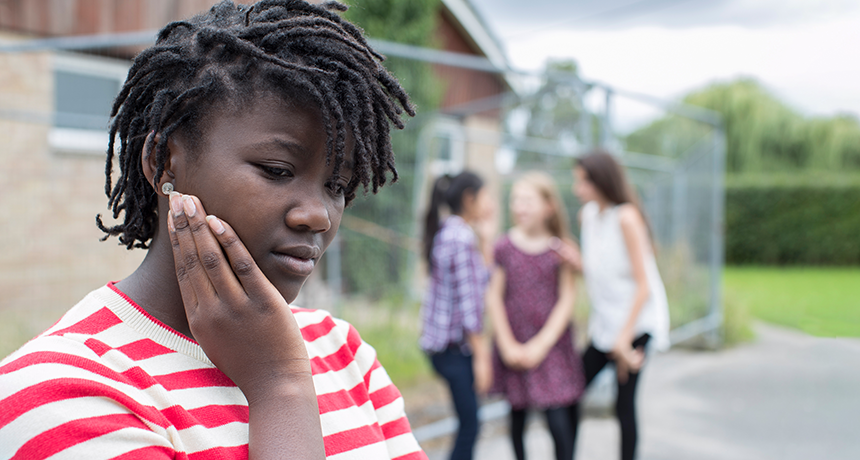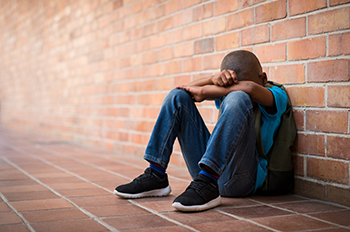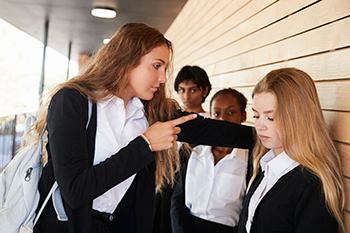School bullying has risen in areas that supported Trump
Teasing and bullying based on race rose in those areas as well, researchers report

Students reported a jump in incidents of bullying about race in areas of Virginia where voters supported Donald Trump in the 2016 presidential election, a new study finds.
Daisy-Daisy/iStockphoto, adapted by L. Steenblik Hwang
Since the 2016 election for U.S. president, bullying and teasing are up in many middle schools. Much of the increase showed up in communities that supported Republican Donald Trump, a new study finds. Before that election, there had been no difference between schools in bullying rates between those that favored either Republicans or Democrats.
The study is based on surveys of more than 155,000 seventh- and eighth-graders in Virginia. Surveys took place both before and after the 2016 election.
“We’ve got good evidence that there has been a real increase in bullying and in racial and ethnic teasing in certain schools,” says Dewey Cornell. He’s a psychologist at the University of Virginia in Charlottesville. Although his data come from only one state, he thinks the trend they saw “certainly would apply” to the rest of the United States. “I don’t think there’s anything about Virginia that would make bullying or teasing in Virginia more or less responsive to public events,” he says.
News stories have reported large numbers of incidents of racism since the 2016 election.
The Southern Poverty Law Center (SPLC) has surveyed more than 2,500 educators. Many said that bullying echoed slogans and rallying cries from the election. “Trump! Trump!” chanted two white students who blocked a black student from his classroom in Tennessee. “Trump won, you’re going back to Mexico!” threatened students in Kansas. And so on.
But the SPLC survey was not a representative sample. And news stories often mentioned only specific cases. Says Cornell, such anecdotes “might be misleading.”
“These taunts and jibes will still be hurtful to kids,” says his co-author Francis Huang. He’s a statistician who studies educational issues at the University of Missouri in Columbia. “One of the reasons that we did the study,” he says, “was that we read that a lot of [bullying] was going on, and especially that minority students were being targeted.”
Digging into the data
Every other year, Virginia surveys representative samples of seventh- and eighth-graders. Each set of survey questions asks about teasing and bullying. Huang and Cornell used those data for their new analysis.
Among other things, the surveys asked students if they have been victims of bullying. It also asked about what students saw. Were students teased about their clothing or appearance? Did they see a lot of teasing that deals with sexual topics? Did they see teasing that attacked a student’s sexual orientation? Were students put down because of their race or ethnic group?
The team analyzed the survey data from 2013, 2015 and 2017. The 2015 data showed no difference in bullying based on voter preferences in the prior elections for the districts in which the schools were located. By 2017, that changed — and in a big way.

“In regions that favored the Republican candidate [Trump], bullying was higher by about 18 percent,” Cornell says. What that means: About one in every five students in the areas that voted for Trump had been bullied. That’s 20 percent. In Democratic areas, it was 17 percent. That’s a bit fewer than one in every six students. “Before the election,” he notes, “there were no differences between these two groups of schools.”
Also, in areas where support for Trump had been highest, the rate of bullying and teasing climbed the most. For every extra 10 percentage points by which an area had voted for Trump, there was about an 8 percent jump in middle-school bullying.
Reports of teasing or put-downs because of race or ethnic groups were 9 percent higher in communities that backed Trump. Roughly 37 percent of students in Republican areas reported being bullied in 2017 compared to 34 percent in Democratic areas.
Cornell and Huang shared their findings January 8 in Educational Researcher.
Why the change?
The new findings are correlations. They link events but don’t establish that one caused another. Still, the findings raise questions. Did students hear taunts from Trump himself? Did they mimic what they heard parents say? Maybe they thought bullying had become okay based on what they saw on Facebook, Twitter and other social media.
The results might also reflect a general rise in hostility. In a survey of U.S. high school teachers across the nation, about one in every four said that after the 2016 election, students had made nasty remarks about other groups in class. A team at the University of California, Los Angeles reported those data in 2017.
Cornell would love to know what Science News for Students’ readers see as the causes for more bullying and teasing at school. “It would be great if we got information from the kids,” he says.
Alex Pieterse is a psychologist at the University at Albany in New York. He says the study by Cornell and Huang “is really well done.” He especially likes how the team worked with the data and analyzed it with statistics. It’s a great example, he says, of how science can study things “that have an important impact on people’s lives.” After all, “science is not just about going to the moon. It’s also about how we treat each other as people.”
“Kids ought to be concerned about bullying — any kind of bullying,” Cornell says. The more teasing and bullying there is in a school, the more poorly students are likely to perform in class. Bullied kids are more likely to develop emotional and social problems. They also will be more likely to engage in risky behaviors, he says, such as substance abuse or fighting.
The bump in racial and ethnic bullying worries Pieterse. “If you are being bullied because of your racial background, it’s about being part of these larger groups,” he says. This bullying isn’t about something a person did, but about who they are. The person who is bullied may end up “feeling more powerless,” he says.
Pieterse felt the effects of racism when he was a black child in South Africa. At the time, laws there severely limited the rights of black people. The new study, he says, may be a sign of more hatred against people seen as “others.” For instance, he points to a recent rise in hate crimes in the 10 largest U.S. cities. In these places, hate crimes rose 12.5 percent in 2017, compared to just one year earlier (the year before the election). Those stats come from a May 2018 report by researchers at California State University at San Bernardino.
What can you do?
Regardless of the cause of bullying, there are steps that kids, parents and educators can take, Huang says. Research shows that anti-bullying programs can reduce incidents by about 20 percent. Trends from the new study can alert schools to a possible risk. If schools don’t act, teens and ‘tweens can also ask parents and school boards to step in.

If someone bullies you, speak up, Cornell says. Tell the bully to stop it! He notes that “Sometimes kids don’t realize how hurtful their behavior is.” And if that request doesn’t work, talk to a trusted adult, he says.
Pieterse echoes the advice to tell someone about every instance of bullying. “You’ll feel better about yourself because you’ve done something,” he says. Remember, too, that bullying isn’t really about anything you did. “It’s about the person who is doing the bullying.” Bullying is one way that people try to exert power over others.
And even if you aren’t bullied, speak up when you see it happen to others, add Cornell and Huang. Both want bystanders to become “up-standers.” Make it clear you’re not okay with bullying. Provide support to students who are being bullied. And tell the bullies to stop it. If that doesn’t work, Cornell says, seek out an adult.
After all, bullying doesn’t just hurt its victims. Bullying can turn schools into hostile places. And then everyone suffers.







